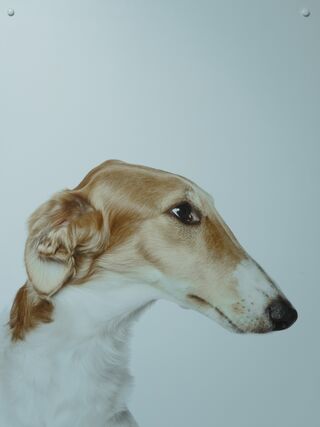Scent
How Dogs “See” Smells
Hyperfocused on outside smells, less so on what's in their mouths.
Posted October 20, 2022 Reviewed by Lybi Ma
Key points
- So adapted are dogs for smelling the outside world that they have little ability to smell the food in their mouths.
- Researchers found extensive connections between the olfactory bulb and the occipital lobe, which houses the visual system.
- We can't peer inside their heads to see what it feels like to be a dog, but it must be a world full of vivid smells.

Dogs are famous for their noses. Not only do they inspect almost everything with their noses, but their heads are also designed and geared toward smelling what's around them. New research suggests that dogs' brains are also specially adapted for smell by harnessing the power of their visual system.
Dogs' Noses Smell the World, Not What's in Their Mouths
Think of the massive snout of a borzoi. It gathers in big gulps of air for inspection by olfactory sensory neurons in the nasal cavity. But it also has limitations.
So adapted are dogs to smelling the outside world that they have little ability to smell food in their mouths. When humans chew food, we force gases escaping from the food up into our nasal cavity via passageways in the back of the throat. This process, called retronasal olfaction, partially reverses the flow of air in the nose, which normally comes in through the nostrils. Much of our experience of the flavor of food derives from these “backward” smells, which are combined in the brain with true tastes (sweet, salty, bitter, sour, and umami) sensed with the tongue. The pleasure we derive from food, like the richness of chocolate, is largely down to this combined sensation.
But the internal anatomy of a dog’s head allows little of this backward airflow. Dogs mostly lack the combined feeling of smell and taste that makes up flavor. As a result, they care little about the flavor of their food once it is in their mouths. Detecting the smells of edible things before opening their mouths is enough for them to take a bite.
With the flavor-constructing function of smell demoted, dog noses are instead built around mapping out and identifying the smells all around them. And there are lots of odors out there. We humans might well be able to smell many of the same chemicals that dogs do. But, standing upright, we are much further away from the ground, which is where most of the interesting smells are. Indeed, one famous study found that humans have similar abilities to dogs in following a scent trail through grass. Some of a dog’s powerful sense of smell may be down to practice.
But their massive nasal cavities certainly help. And they can take 10 breaths of air through their nostrils in the time it takes humans to draw in one breath.
Genes and Neural Systems for Smell
Scientists have looked at genetics and neurophysiology to find sources of dogs’ enhanced sense of smell. While dogs have large numbers of olfactory receptor neurons in their noses—2 billion, compared to our 50 million—their genes endow them with essentially the same set of detectors as us and other mammals. This suggests that the variety of different smells dogs can detect is comparable to the number that we can detect, though dogs can detect much smaller concentrations of odorants.
What the dog’s brain does with this information seems quite different from what is found in people. We are starting to get a sense of this processing difference with an innovative new study of connectivity in the dog brain carried out at Cornell University Veterinary College.
Strong Connections Discovered Between the Olfactory Bulb and Visual Brain in Dogs
Before the Cornell team's work, little was known about connectivity in the dog brain related to olfaction. Using magnetic resonance imaging in living dogs, along with confirmatory dissection studies in deceased dogs, the researchers found extensive connections between the olfactory bulb, which receives signals from the nose's olfactory sensory neurons, and the occipital lobe, which houses the visual system. The connections are formed by axons that stretch from the front of the brain to the back.
No direct connections between these two brain regions have been reliably observed in any other species. This includes the well-studied mouse, which is also a highly smell-oriented species. In dogs, these white matter tracts between the olfactory bulb and the visual brain were not just present, they were thick. The axons occupied a volume equivalent to around a third of a teaspoon. This is more than 1 percent of the dog's entire brain, which includes not just axons but also the cell bodies and dendrites of more than 2 billion neurons, which carry out a host of jobs.
The Cornell team also discovered new tracts linking the olfactory bulb and other parts of the brain including the limbic system and systems related to memory and navigation. But the extraordinarily strong connections to the visual system stand out. They suggest that dogs integrate smell information very early on in the processing of the visual world.
Since dogs are domesticated, their evolution has been strongly influenced by us. It remains unknown whether this brain specialization is shared with wild relatives of dogs, or whether it emerged as a result of breeding by humans.
Can Dogs See Smells?
As far as what this study means for how dogs perceive the world, I would speculate that smells might be a kind of overlay directly on top of their visual awareness. Perhaps it is something like the way objects around us have visual form and identity, as well as a distinct feeling or vibrancy of color. We can't peer inside their heads to see what it feels like to be a dog, but it must be a world full of vivid smells.
Copyright © 2022 Daniel Graham. Unauthorized reproduction of any content on this page is forbidden. For reprint requests, email reprints@internetinyourhead.com.
Facebook/LinkedIn image: everydoghasastory/Shutterstock
References
Andrews, E. F., Pascalau, R., Horowitz, A., Lawrence, G. M., & Johnson, P. J. (2022). Extensive Connections of the Canine Olfactory Pathway Revealed by Tractography and Dissection. Journal of Neuroscience, 42(33), 6392-6407.
Dunn, R., & Sanchez, M. (2021). Delicious: the evolution of flavor and how it made us human. Princeton University Press.
Jardin-Messeder, D., Lambert, K., Noctor, S., Pestana, F. M., de Castro Leal, M. E., Bertelsen, M. F., ... & Herculano-Houzel, S. (2017). Dogs have the most neurons, not the largest brain: trade-off between body mass and number of neurons in the cerebral cortex of large carnivoran species. Front Neuroanat, 11(118), 1-18.
Porter, J., Craven, B., Khan, R. M., Chang, S. J., Kang, I., Judkewitz, B., ... & Sobel, N. (2007). Mechanisms of scent-tracking in humans. Nature neuroscience, 10(1), 27-29.




